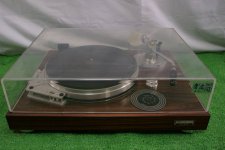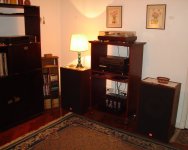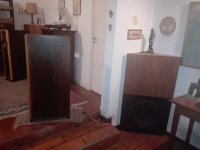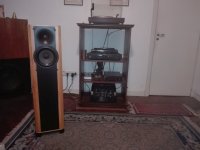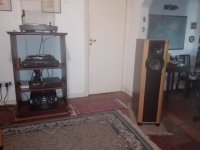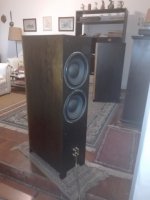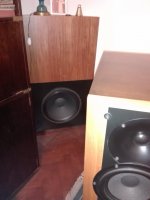Hi academia50,A high-mass platter of turntable increases rotational stability, thus decreasing wow and flutter. No matter the transmission system, it is always better. The first Lenco chainrings were steel and light, then aluminum and heavy, don't be fooled by what you see on the surface, the rest is below. Here you can see a lot of Diyer's work, many use the platter and the engine of the L 75. There is a job that appears to be two stacked steel B-52/55 chainrings, there are even TTs with linear travel arms! To recreate the view, that's Diy's ! 👍
https://www.lencoheaven.net/forum/index.php?topic=2115.0
what is a "chainring"?
Sincerely,
Ralf
Ralf
Haha, it's happened to me other times, I usually check what GT translates before pressing the "upload" button, since I'm not fluent in English. But sometimes something escapes, although others understood it perfectly.
Platter is the right word in english, it's that round thing that I uploaded in the photo of post 210.
Haha, it's happened to me other times, I usually check what GT translates before pressing the "upload" button, since I'm not fluent in English. But sometimes something escapes, although others understood it perfectly.
Platter is the right word in english, it's that round thing that I uploaded in the photo of post 210.
Put a sheet of A4 paper between platform and the sub-chassis at a Linn or Thorens turntable under the headshell and I think you can hear the differences. 😀😀🥴
Those designs started with the Micro Seiki DQX 500. I used it.There are definitly different approaches, but if i had the money to spend on a new TT, i would get one of the top-of-line Rega’s
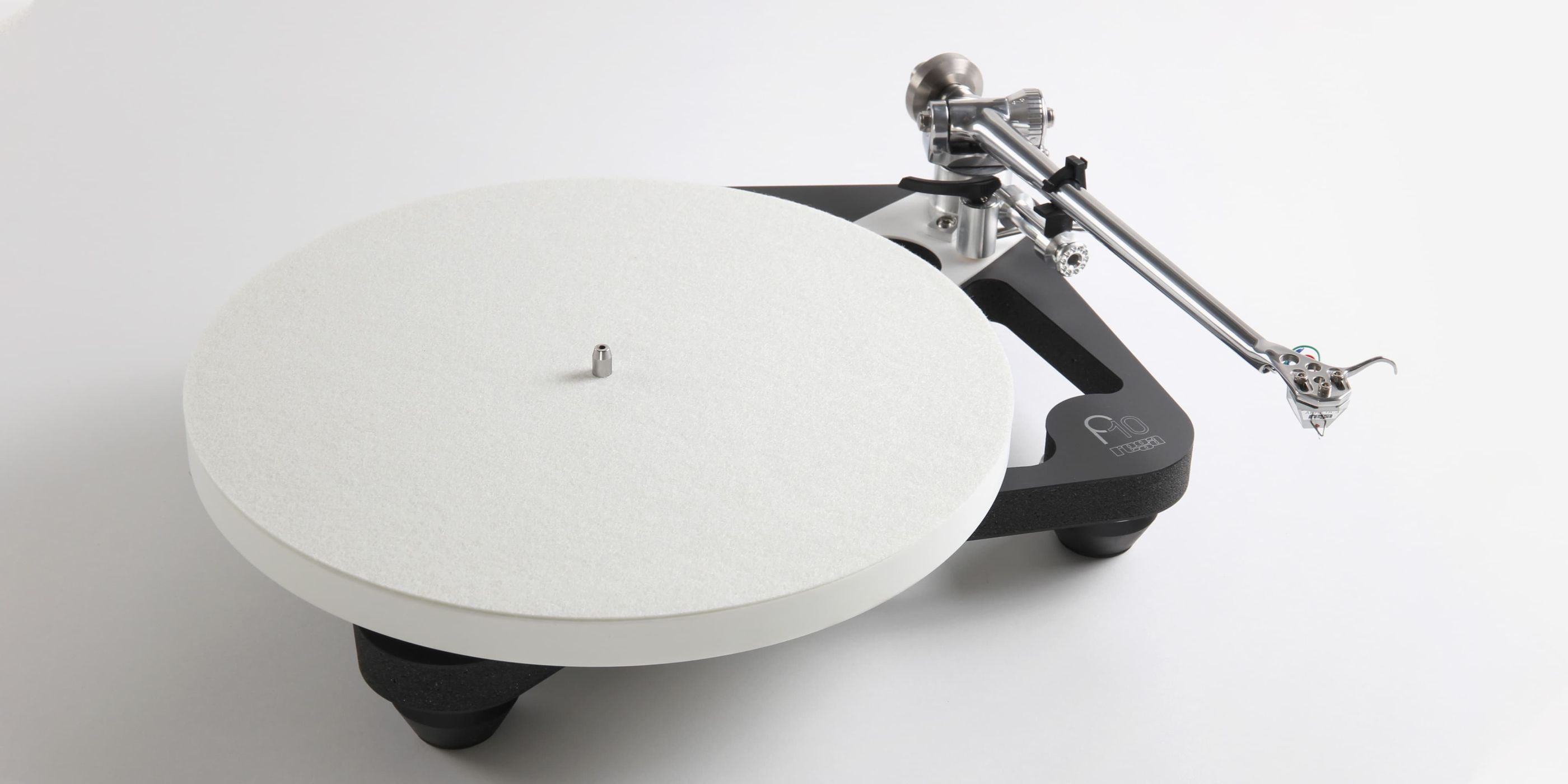
dave
I also used MS BL-51. A large, solid plinth, quite heavy chainring without going to the extremes of some current designs, belt drive and MA-505 tonearm. If I could have bought one of those I would never have abandoned it. What beauty and great performance ! My preference.
Probably these modern designs without cabinets (horrible for my taste, sorry) aim, in addition to being something "different" aesthetically, that this plinthless configuration is less likely to capture acoustic feedback. There are times when at high volumes, the difference between listening to music with the cover open or closed makes the difference whether or not the AR appears. Everything sounds great, loud and clear, so you decide to lower the lid to protect your precious vinyl from dust, and the phenomenon appears.
What would seem to show that it occurs when sound waves make the entire structure vibrate, through the largest surface of the acrylic lid. The same "up" or "down" makes a big difference. Serious - and wealthy - audiophiles don't use TT with furniture. What makes it more inexplicable for me that the AR is not present under any circumstances in the classic TT of the man of the repeated sepia photos....
I have noticed that there are practically no more manufacturers that use "classic" cabinets in their products. (Project, Rega, etc.) And the very high-end TTs, they all come "naked", without clothes, which shows that audio is a Totally pornographic question!
And to close my participation here I conclude that AR is a problem of physical laws, and has no solution in certain closed environments. As I said before, in the garden, you can give it all the volume you want that even the cheapest and most shabby TT will not find out about the AR, you will only have to deal with your neighbor. Which is no small thing.
May they continue well. 🙂
Attachments
Interesting, but I don't have access to any of those TTs.....Put a sheet of A4 paper between platform and the sub-chassis at a Linn or Thorens turntable under the headshell and I think you can hear the differences. 😀😀🥴
Ops, forgot to reply, sorry. I found a picture of my system before the update and took pictures today (terrible quality, forgot to turn off the flash) so you can see how it is now. I didn't like the cabinet with those flimsy feet, (inherited from my dear father-in-law) the amplifier alone weighs 30 Kg., so I modified it, made a base with wheels and mounted the cabinet on a sandwich of " hardboard " and " Eva rubber" plate. The "parquet" floor was spoiling for the whells, but although WAF is already resigned, it was a mischief. I think the acoustic coupling issue has something to do with the large amount of SD radiating from all the speakers in the room, 2x18 " subwoofers, 2x8 " midrange, and the DTQWTII have 2x10 each that point towards the TT and interfere with sub´s . I tried inverting the phase of the subwoofers but nothing changed.What kind of stands are your TT's on?
So when a visitor (an audiophile fanatic like me, haha) tells me, "turn it louder", I put cotton in my ears and then ask him to choose a CD from my collection or search my smartphone / Tidal for his favorite topic. They are usually speechless.
Greetings.
Rolo
Attachments
Last edited:
I've owned a Rega RP8 with Aphetta 2 and was never happy with it so I bought a Technics SP10mk2 / EPA100 / ECP205 and plonked it on the floor near the Rega, the next day the Rega was on the market. I would never buy another Rega product.
My now highly modified SP10mk2 sits on a Minus K in another room away from my lounge room.
My now highly modified SP10mk2 sits on a Minus K in another room away from my lounge room.
The rega brand is overhyped, and consumer reviews are opposite reviews by so-called online magazine critics.I've owned a Rega RP8 with Aphetta 2 and was never happy with it so I bought a Technics SP10mk2 / EPA100 / ECP205 and plonked it on the floor near the Rega, the next day the Rega was on the market. I would never buy another Rega product.
My now highly modified SP10mk2 sits on a Minus K in another room away from my lounge room.
I'd never want one.
Besides, rega never publishes wow/flutter/rumble specs.
Why the secret?
So as I have an ol' P3 with RB300 had to look up his website and found this..Its worth having a careful look at what Mr Baker at Origin Live does, a thorough read of his website will provide all sorts of interesting information and his kit is well thought of...........
https://www.originlive.com/hi-fi/rega-tonearm-upgrade-modification/
where he says...
"The Rega counterweight is excited into resonance by the motion of the arm. This means it should be decoupled and yet also remain rigid to the tonearm. The beauty of the Origin Live Rega tonearm modification is that it acts as a shock absorber for waves traveling down the arm from the cartridge, and also acts to de-couple the Rega counterweight whilst maintaining rigidity."
And further on suggests to replace the original counterweight for one that gets rigidly clamped onto the stub at the end of the tonearm via an Allen bolt, whereas the original counterweight uses two rubber O-rings sitting inside the counterweight in two grooves (see attached pic) to isolate it from the arm and therefore is already de-coupled so to speak, that metal-rubber-metal acts as a CLD which dampens any resonances, but his tweak removes this very action, ie. just another piece of audiophoolery tweaking advice. The piece mentioning change of stub doesn't make sense either, it's already rigidly fixed to the tonearm.
Such idiotic "modifications" to tonearms and other parts of various "recent" turntables only make me shake my head and laugh.So as I have an ol' P3 with RB300 had to look up his website and found this..
https://www.originlive.com/hi-fi/rega-tonearm-upgrade-modification/
where he says...
"The Rega counterweight is excited into resonance by the motion of the arm. This means it should be decoupled and yet also remain rigid to the tonearm. The beauty of the Origin Live Rega tonearm modification is that it acts as a shock absorber for waves traveling down the arm from the cartridge, and also acts to de-couple the Rega counterweight whilst maintaining rigidity."
.... but his tweak removes this very action, ie. just another piece of audiophoolery tweaking advice. The piece mentioning change of stub doesn't make sense either, it's already rigidly fixed to the tonearm.
Decouple this part, add litz wire to that part, change this part, that part, another part...... it's utter nonsense.
Think about this for a moment....
You purchase a relatively expensive turntable, then are faced with internet-based blabber about modifying it and spending yet more money to gain some additional heavenly pleasure from it?
And you've now got a new, brainwashed mind believing all that nonsense, a perceived sense of comfort knowing that you've followed some trail of eternal holy benefit - because someone online that you've never even met told you to do it.
It's Marketing Greed/Propoganda at its finest!
First off, decades ago, manufacturers like Dual/United Audio, already perfected and developed decoupling of their tonearms - and there was no discussions suggesting that anything had to be "changed or modded".
They never needed a new "sub-platter" replacement, sub-platter bearings, or a new "upgraded motor", or any other additional messing around with.
Those Duals had everything already perfected, no need to spend more money on them.
And yet even today, all that is needed is some re-lubricating and proper servicing due to normal aging.
So why does a newer manufacturer like rega and many others, produce these sub-standard creations without considering previous benefits of the past?
By the way, the P8 is listed as having about a 0.7% wow/flutter rating, which in my opinion is lousy for something so expensive.
Many other brands also hover around such crappy specs too.
You'd think that today, they'd have such a rating equal to or lower than many of those Golden Era machines which didn't need a thing improved.
My "cheap" 1980's Kenwood is rated for 0.025%, and actually today measures at 0.028% - far far lower than a turntable made today.
Think about it.
And also, think about this...
Do you ever hear of any negative reviews of current audiophile turntables?
No.
You always hear those repeated praises about "soundstage", swiftness, airy-ness, resolution, etc etc.
Because the magazine reviewer is paid to praise those things, unlike decades ago when they actually were allowed to tell the truth.
I have no "axe to grind" in respect of this but i have found a lot of good sense in what Origin Live write and do, so I expect there is something not being thoroughly understood in the descriptions that you quote and then criticise.So as I have an ol' P3 with RB300 had to look up his website and found this..
https://www.originlive.com/hi-fi/rega-tonearm-upgrade-modification/
where he says...
"The Rega counterweight is excited into resonance by the motion of the arm. This means it should be decoupled and yet also remain rigid to the tonearm. The beauty of the Origin Live Rega tonearm modification is that it acts as a shock absorber for waves traveling down the arm from the cartridge, and also acts to de-couple the Rega counterweight whilst maintaining rigidity."
And further on suggests to replace the original counterweight for one that gets rigidly clamped onto the stub at the end of the tonearm via an Allen bolt, whereas the original counterweight uses two rubber O-rings sitting inside the counterweight in two grooves (see attached pic) to isolate it from the arm and therefore is already de-coupled so to speak, that metal-rubber-metal acts as a CLD which dampens any resonances, but his tweak removes this very action, ie. just another piece of audiophoolery tweaking advice. The piece mentioning change of stub doesn't make sense either, it's already rigidly fixed to the tonearm.
View attachment 1077956
Why do i say that? I have seen lots of posts which ignore some factors or are based on a lack of thorough understanding and subsequently are corrected by others.
However i might well be wrong! - i am completely self sufficient in errors and mistakes.
So, I had an old P3 and 300 as well, and never found it performed anything better than adequate, after a direct comparison i replaced it and subsequently have made my own radial tone arm.
I both listen to this and measure its performance to make judgements in my quest to improve it.
It sounds good and produces good measured results.
I have found improvements are available in similar areas to those described, even though it is based on fundamentally different principles. I have only found decoupling to be of benefit when something else in the chain is inadequate in what it is doing and the decoupling can mask that problem, but get the fundamentals improved and the decoupling results in inferior performance.
"The Rega counterweight is excited into resonance by the motion of the arm…
Very true, here for the diyers.
http://p10hifi.net/forum/rega-counter-weight.pdf
Note that also changing the steel nut on the bearing with a teflon one also helps.
dave
I'll stick with our modded AR thanks you.
I have done quite a few of those. This is teh TT that really started the “better” TT revolution inspiring both the Ariston and the much better Linn. And it was Lin that largely drove a change in attitude towards how TTs were looked at.
I gave my last AR to a buddy who had a spare Formula 4 to mount on it — the F4 and Gravce 707, along with the big washers that coe with every 707 were quite easy to retrofit on them.
dave
I said that I ended my intervention here, but I am going to break my word. Those who have in their hands the destruction of the world or not do it, so why can't I do it ? 😢
" The Resolution allowed that ‘Big Bass’ usually found in mega-priced, mega-mass anvil turntables, but without the turgidity, lead-footedness, and rhinocerine mud-wallowing the type too often struggles with. Instead, bass was agile, able to dance, and fully punchy, dynamic, and sonorous. " 😳
http://v2.stereotimes.com/post/the-origin-live-resolution-mk-4-turntable
I love the descriptions that the reviewers do appealing to this type of examples, to describe the advantages of the products that have been given to them in review. Sometimes I think they made a mistake in their choice to earn their daily bread.... 🙄
" The Resolution allowed that ‘Big Bass’ usually found in mega-priced, mega-mass anvil turntables, but without the turgidity, lead-footedness, and rhinocerine mud-wallowing the type too often struggles with. Instead, bass was agile, able to dance, and fully punchy, dynamic, and sonorous. " 😳
http://v2.stereotimes.com/post/the-origin-live-resolution-mk-4-turntable
I love the descriptions that the reviewers do appealing to this type of examples, to describe the advantages of the products that have been given to them in review. Sometimes I think they made a mistake in their choice to earn their daily bread.... 🙄
No axe to grind yet the snide insinuations pertaining to ignorance and lack of understanding without any further explanations is the way to go. Do you happen to be a Britt, maybe even a good buddy of Mr Baker, perhaps?I have no "axe to grind" in respect of this but i have found a lot of good sense in what Origin Live write and do, so I expect there is something not being thoroughly understood in the descriptions that you quote and then criticise.
Why do i say that? I have seen lots of posts which ignore some factors or are based on a lack of thorough understanding and subsequently are corrected by others.
However, one do not have to look further for Mr Bakers thick marketing gospel than scrolling down a bit on the linked page given above and read:
"rewiring Rega arms are well documented and the effects are clearly audible in greater transparency and definition".
Just a short piece of wire makes a world of audible difference... that's enough of audiophoolery for me.
Very true..
Alright, as if not all tonearms are suffering from some resonances, so what kind of resonances are we seeing on an unmodified RB300 or alike arm model from Rega that are problematic?
Any before and after mod measurements somewhere?
Last edited:
I have heard the difference, Chris’ Rega III was everybit as good as his Linn. Not my design or product, just a drawing never released before.
dave
dave
Thank you for your enlightenment.Such idiotic "modifications" to tonearms and other parts of various "recent" turntables only make me shake my head and laugh.
Decouple this part, add litz wire to that part, change this part, that part, another part...... it's utter nonsense.
Think about this for a moment....
You purchase a relatively expensive turntable, then are faced with internet-based blabber about modifying it and spending yet more money to gain some additional heavenly pleasure from it?
And you've now got a new, brainwashed mind believing all that nonsense, a perceived sense of comfort knowing that you've followed some trail of eternal holy benefit - because someone online that you've never even met told you to do it.
It's Marketing Greed/Propoganda at its finest!
First off, decades ago, manufacturers like Dual/United Audio, already perfected and developed decoupling of their tonearms - and there was no discussions suggesting that anything had to be "changed or modded".
They never needed a new "sub-platter" replacement, sub-platter bearings, or a new "upgraded motor", or any other additional messing around with.
Those Duals had everything already perfected, no need to spend more money on them.
And yet even today, all that is needed is some re-lubricating and proper servicing due to normal aging.
So why does a newer manufacturer like rega and many others, produce these sub-standard creations without considering previous benefits of the past?
By the way, the P8 is listed as having about a 0.7% wow/flutter rating, which in my opinion is lousy for something so expensive.
Many other brands also hover around such crappy specs too.
You'd think that today, they'd have such a rating equal to or lower than many of those Golden Era machines which didn't need a thing improved.
My "cheap" 1980's Kenwood is rated for 0.025%, and actually today measures at 0.028% - far far lower than a turntable made today.
Think about it.
And also, think about this...
Do you ever hear of any negative reviews of current audiophile turntables?
No.
You always hear those repeated praises about "soundstage", swiftness, airy-ness, resolution, etc etc.
Because the magazine reviewer is paid to praise those things, unlike decades ago when they actually were allowed to tell the truth.
Sad that you choose to be so aggressive in your response, nothing snide and no insinuations in my original at all, maybe try reading my original again with an open mind and you may find I already say that i may be wrong and have made many mistakes, but also that i have made many measurements of my own work which leads me to suggest that with an open mind one can look further and see possibilities that are not at first apparent. I learnt lots by doing that, some kind folks persisted in suggestions to me and i both learnt as a result and changed my perception as a result. i have loads to learn so any feedback I can learn from is always welcome to me, best, mikeNo axe to grind yet the snide insinuations pertaining to ignorance and lack of understanding without any further explanations is the way to go. Do you happen to be a Britt, maybe even a good buddy of Mr Baker, perhaps?
However, one do not have to look further for Mr Bakers thick marketing gospel than scrolling down a bit on the linked page given above and read:
"rewiring Rega arms are well documented and the effects are clearly audible in greater transparency and definition".
Just a short piece of wire makes a world of audible difference... that's enough of audiophoolery for me.
Alright, as if not all tonearms are suffering from some resonances, so what kind of resonances are we seeing on an unmodified RB300 or alike arm model from Rega that are problematic?
Any before and after mod measurements somewhere?
- Home
- Source & Line
- Analogue Source
- Can one turntable sound better than another?

